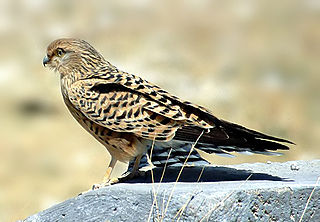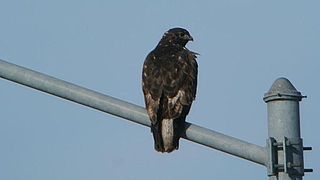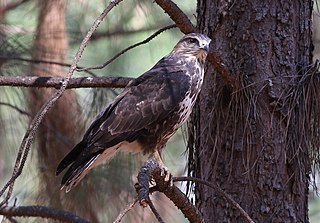
The common buzzard is a medium-to-large bird of prey which has a large range. A member of the genus Buteo, it is a member of the family Accipitridae. The species lives in most of Europe and extends its breeding range across much of the Palearctic as far as northwestern China, far western Siberia and northwestern Mongolia. Over much of its range, it is a year-round resident. However, buzzards from the colder parts of the Northern Hemisphere as well as those that breed in the eastern part of their range typically migrate south for the northern winter, many journeying as far as South Africa.
Buzzard is the common name of several species of birds of prey.

The rough-legged buzzard or rough-legged hawk is a medium-large bird of prey. It is found in Arctic and Subarctic regions of North America, Europe, and Russia during the breeding season and migrates south for the winter. It was traditionally also known as the rough-legged falcon in such works as John James Audubon's The Birds of America.

The sharp-shinned hawk is a small hawk, with males being the smallest hawks in the United States and Canada, but with the species averaging larger than some Neotropical species, such as the tiny hawk. The taxonomy is far from resolved, with some authorities considering the southern taxa to represent three separate species: white-breasted hawk, plain-breasted hawk, and rufous-thighed hawk. The American Ornithological Society keeps all four variations conspecific.

The Harris's hawk, formerly known as the bay-winged hawk, dusky hawk, and sometimes a wolf hawk, and known in Latin America as peuco, is a medium-large bird of prey that breeds from the southwestern United States south to Chile, central Argentina, and Brazil. Birds are sometimes reported at large in Western Europe, especially Britain, but it is a popular species in falconry and these records almost invariably all refer to escapes from captivity.

The long-legged buzzard is a bird of prey found widely in several parts of Eurasia and in North Africa. This species ranges from Southeastern Europe down to East Africa to the northern part of the Indian subcontinent. The long-legged buzzard is a member of the genus Buteo, being one of the larger species therein. Despite being relatively powerful, it is considered a rather sluggish raptor overall. Like most buzzards, it prefers small mammals such as rodents, including gerbils, ground squirrels, voles and rats, also taking reptiles, birds and insects as well as carrion. Adaptable to a variety of habitats, long-legged buzzards may nest on a variety of surfaces, including rocks, cliffs and trees. it is a typical buzzard in its reproductive biology. The long-legged buzzard is widely distributed and appears to be quite stable in population. Therefore, it is considered as Least Concern by the IUCN.

The zone-tailed hawk is a medium-sized hawk of warm, dry parts of the Americas. It is somewhat similar in plumage and flight style to a common scavenger, the turkey vulture, and may benefit from being able to blend into groups of vultures. It feeds on small terrestrial tetrapods of all kinds.

The greater kestrel or white-eyed kestrel, is a bird of prey belonging to the falcon family Falconidae. It is one of the largest kestrels and is found in open country in southern and eastern Africa.

The black-chested buzzard-eagle is a bird of prey of the hawk and eagle family (Accipitridae). It lives in open regions of South America. This species is also known as the black buzzard-eagle, the gray buzzard-eagle or analogously with "eagle" or "eagle-buzzard" replacing "buzzard-eagle", or as the Chilean blue eagle. It is sometimes placed in the genus Buteo.

The jackal buzzard is a fairly large African bird of prey. The taxonomy of this species has caused some confusion in the past and it almost certainly belongs in a species complex with other African Buteo species. Some taxonomists have considered this species, the Archer's buzzard, and the augur buzzard to be the same superspecies. Many taxonomists consider them all to be distinct, having different calls, different home ranges and variations in plumage. This is a species that lives among mountains, and on adjacent savanna and grassland. It is resident and non-migratory throughout its range.

The augur buzzard is a fairly large African bird of prey. This species is distinct in typical adult plumage for its blackish back, whitish underside and orange-red tail, however a dark morph is known while juvenile augur buzzards are generally rather brown in colour. This member of the Buteo genus is distributed in several parts of the central and southern Africa, normally being found from Ethiopia to southern Angola and central Namibia. It is resident and non-migratory throughout its range. This is a species of mountains, and adjacent savannah and grassland. This is a typical buteonine raptor, being a generalist predator which tends to prefer small mammals supplemented by reptiles and birds among various prey items.

The mountain buzzard is a bird of prey that lives in montane forests in East Africa, it and the forest buzzard of southern Africa were, until recently, considered to be a single species.

The grasshopper buzzard is a species of bird of prey in the family Accipitridae which is found in a narrow zone of sub-Saharan Africa north of the equator.

The Socotra buzzard is a medium to large bird of prey that is sometimes considered a subspecies of the widespread common buzzard. As its name implies, it is native to the island of Socotra, Yemen. Although it is listed as vulnerable in the IUCN Red List, its population is considered to be stable.

The variable hawk is a polymorphic species of bird of prey in the family Accipitridae.

The western red-tailed hawk is a subspecies of the red-tailed hawk.

Harlan's hawk or Harlan's red-tailed hawk is a subspecies of the red-tailed hawk.

The gray hawk or Mexican goshawk is a smallish raptor found in open country and forest edges. It is sometimes placed in the genus Asturina as Asturina plagiata. The species was split by the American Ornithological Society (AOU) from the gray-lined hawk. The gray hawk is found from Costa Rica north into the southwestern United States.

The forest buzzard, is a species of bird of prey found in Africa, though some authorities have placed it as a subspecies of another species, the mountain buzzard, Buto oreophilus. This is a resident breeding species in woodlands in southern and eastern South Africa.
The Central American red-tailed hawk is a subspecies of red-tailed hawk resident from Nicaragua to Panama. This subspecies is relatively small. The wing chord of males can range from 368 to 391 mm, averaging 372.7 mm (14.67 in), and, in females, it ranges from 393 to 427 mm, averaging 401.9 mm (15.82 in). Additionally, males and females average 213.2 and 230 mm in tail length, 88.6 and 86.9 mm in tarsal length and 26 and 26.7 mm in culmen length. This race may average around 900 g (2.0 lb). This subspecies is arguably the most handsomely colored in typical adult plumage. This subspecies is dark brown above and heavily pigmented dorsally, the white of the breast contrasting with a deep rufous abdominal band which contains black streaks and spots. Meanwhile, the flanks, wing linings and sides are an unbarred deep rufous. In some birds, the rich rufous color continues to the underside. The chest is much less heavily streaked than in northern migrants western red-tailed hawk to Central America. Unlike other Central American races of red-tailed hawk, there seems to be no dark morph in this subspecies.


















